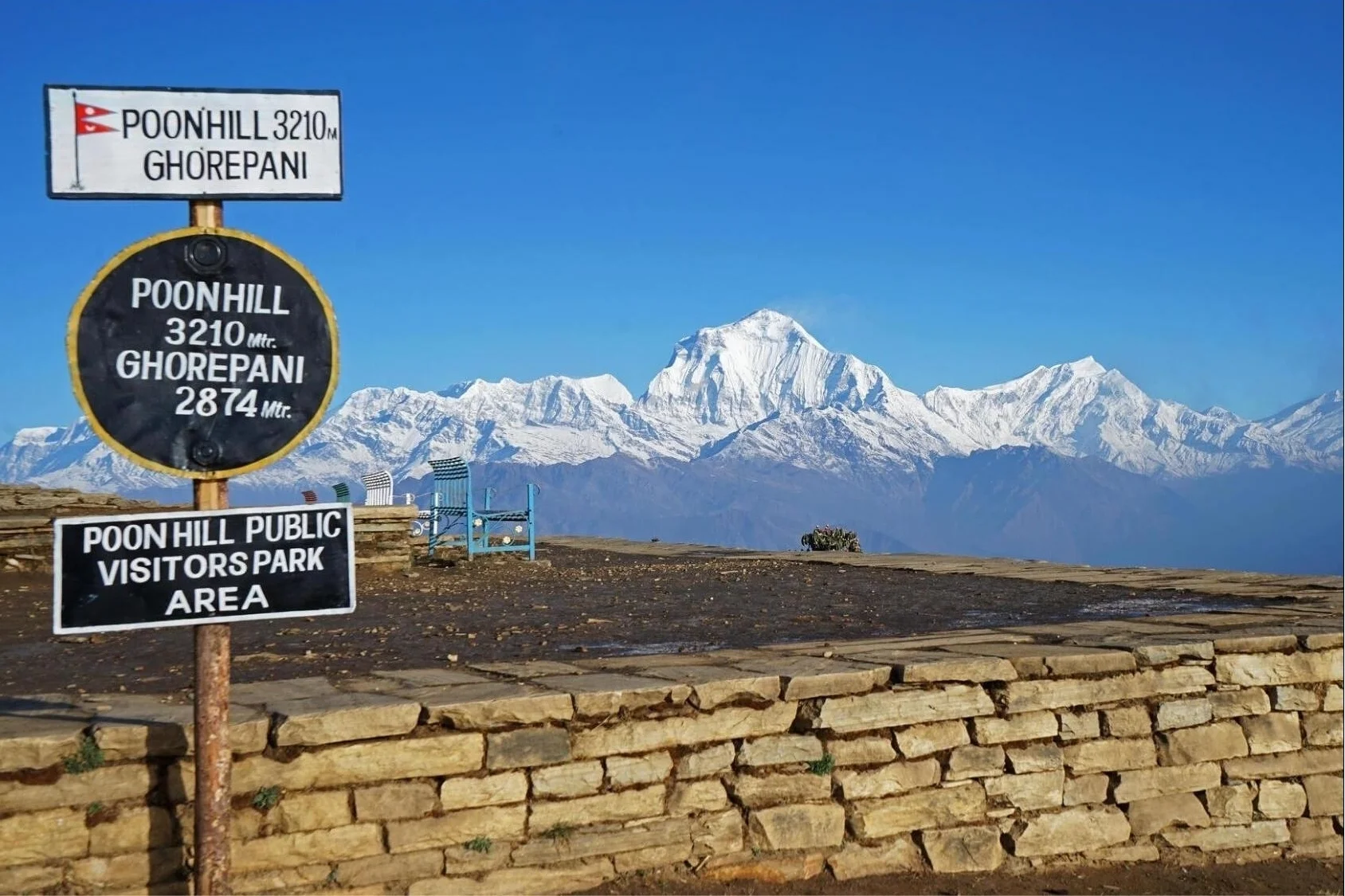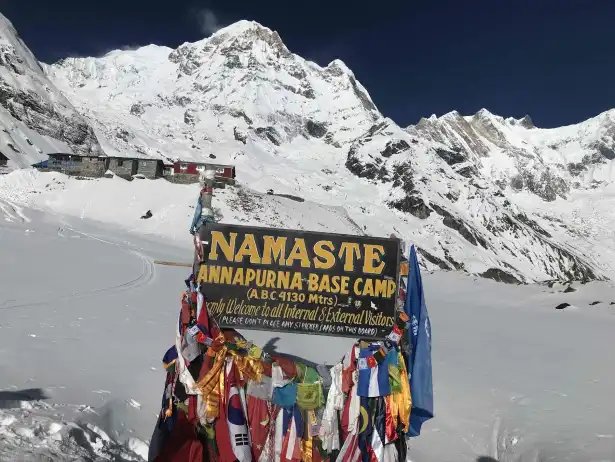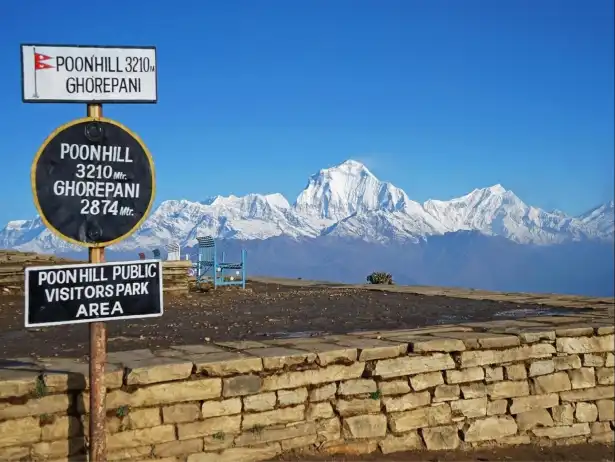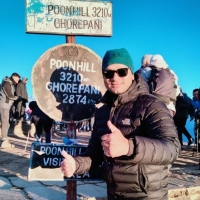Knowledge Networking Portal for Sustainable & Responsible Tourism










 What to Pack for Poon Hill Trek?
What to Pack for Poon Hill Trek?
What to Pack for Poon Hill Trek?

Poon Hill Trek: Overview
Poon Hill Trek is one of the most favorite short treks in Nepal. It is renowned for spectacular sunrise views of the Annapurna and Dhaulagiri ranges. The trek starts at Nayapul, which is at an elevation of around 1,070 meters above sea level. Also, the Poon Hill Trek can be started at Ulleri during dry seasons ( Winter, Autumn and Spring). Actually, Pokhara to Ulleri Jeep ride takes 2-3 hours. From there, the route winds through forests, terraced fields, and villages. Trekkers walk past Gurung and Magar villages during the trek, giving a glimpse of the local people's lifestyle and culture.
In fact, the highest point of the trek is Poon Hill at 3,210 meters. Here, you can see some of the world's highest peaks. They are Annapurna South (7,219 meters), Machapuchare or "Fish Tail" (6,993 meters), and Dhaulagiri (8,167 meters). Many trekkers wake up early to be at Poon Hill before sunrise. This way, they are able to see the beautiful sight of the sun rising above the snow peaks. This is a lifetime adventure and the high point of the trek.
Meanwhile, the Poon Hill Trek can be completed in 4 to 6 days. It is considered beginner-friendly since the trails are well maintained and not very demanding. Accommodation on Poon Hill Trek is in the form of tea houses that offer basic rooms and meals.

Also, the best time for undertaking the Poon Hill trek is during spring (March-May) and autumn (September-November). Theses times have good weather with clear skies for Ghorepani Poon Hill trekking.
In conclusion, Poon Hill Trek is best suited for those who look to experience amazing mountain views in a short and moderate trek near Pokhara. There is no age bar for Poon hill trek and even the elderly people and children above 6 can do Poon hill trek delightfully.
What to pack for Poon Hill Trek?
Proper packing is extremely necessary for Poon Hill Trek. Actually, the weather could change quickly in the hills. Hence, pack such clothes that would keep you dry and warm. Start with moisture-wicking base layers. These do not allow sweat to touch your skin. Then layer up a fleece jacket or an insulation sweater. Likewise, a water-proof jacket is also required so that it would protect you from rain and wind.
Moreover, you should also carry good trekking boots. They have to be comfortable and worn in advance of the trek. Thermal or wool socks ensure that your feet stay warm. Carry a hat to shield against the sun and carry a wool cap for chilly mornings and evenings. Gloves come in handy as it gets cold, especially early morning.
Moreover, for your backpack, choose one with a capacity of between 30 and 40 liters. It should be light but have enough space to carry your basics. Take a 0°C or colder-rated sleeping bag since the nights will be cold. Carry a water bottle and water purification tablets so you can safely drink. Don't forget sunscreen, lip balm, and shades since the sun is strong at higher altitudes.

Besides, carry nuts and energy bars as quick power sources. A headlamp is convenient if you are early morning or late afternoon departures. Carry a small first aid kit for minor injuries. Finally, keep your essential documents, money, and permits safely in a water-proof bag.
In conclusion, intelligent packing for Poon Hill Trek makes you secure, comfortable, and ready for any weather conditions during the trek.
What to Pack for Poon Hill Trek during Autumn?
Autumn is the prime season for the Poon Hill Trek. Indeed, the climate is sunny and bright. So, you can enjoy excellent mountain scenery and pleasant temperatures during your Poon Hill Trek in Autumn. Mornings and evenings may be cool, however, and especially at higher altitudes. So, pack clothing that will keep you warm but at the same time enable you to layer throughout the day.
First, start with moisture-wicking base layers. These will keep your skin dry by not letting the sweat touch it. Add a warm fleece jacket for cold morning and evening sessions. Also, take a good down or insulated jacket for cold evenings. It is also important to take a waterproof and windproof jacket because weather can turn at any time.
Second, for bottoms, use comfortable, quick-drying trekking pants. Pack thermal leggings or long johns to wear underneath for extra warmth. Good hiking boots are a must, and don't forget warm wool socks. Gloves, a woolen hat, and a neck gaiter will protect from cold winds.
Also, pack sun glasses and sun screen as the sun is strong, even if it is freezing. Utilize a 30-40 liter rucksack that will contain all your gear. Carry a sleeping bag that has a rating of at least 0°C, as tea houses can be chilly in the evening.
Further, carry a water bottle and purification tablets for safely staying hydrated. Nuts or energy bars make good snacks for maintaining your energy level. A headlamp is convenient for early morning departures.
In short, packing warm clothing and rain gear is crucial for an enjoyable and secure autumn hike to PoonHill.

Packing for Poon Hill Trek in Spring
Spring is second best time to do the Poon Hill Trek. As a matter of fact, the weather is warmer than in autumn. The forests and hills are full of colorful flowers, especially rhododendrons. So, you would want to pack clothes that will keep you comfortable in cool and warm weather as well.
Foremost, begin with moisture-wicking base layers. These will draw sweat away and keep your skin dry.Include a fleece jacket or lightweight down jacket for mornings and evenings, which can still be cool. Include a waterproof and windproof jacket since spring can also mean some rain and wind.
Moreover, comfortable and quick-drying trekking pants should be worn. Thermal leggings should be brought to wear if it gets cold. Hiking boots are very important. Make sure they are broken in before the trek.Bring several wool or synthetic socks to wear to keep feet warm and dry.
Likewise, bring a woolen hat and gloves for the mornings and evenings. Sunglasses and sunscreen protect you from strong sun rays at high altitudes. A neck gaiter or buff is a good protection from sun and wind.

Also, bring a 30-40 liter backpack to carry your equipment. Bring a sleeping bag with a rating of 0°C or below, since nights are chilly. Carry a refillable water bottle and water purification tablets to ensure safe drinking water. Bring snacks such as nuts and energy bars to keep your energy level up on long walks.
To sum up, dress in layers and bring waterproof equipment for a pleasant Poon Hill Trek in Spring.
What to Pack for the Poon Hill Trek during Winter?
Meanwhile, Poon Hill Trek in Winter can be icy and sometimes snowy. Actually, it can even drop below freezing, especially in the higher altitudes like in Ghorepani(2800m) and Poon Hill (3210m). Therefore, it is most advisable to pack warm clothes and good equipment in order to stay safe and comfortable.
First, start with thermal base layers for bottom and top. These help keep you warm. Add a thick fleece or wool sweater for extra insulation. You need a down jacket suitable for cold weather to warm you from freezing nights. Also, carry a waterproof and windproof jacket to shield you from rain, wind, and snow.
Second, wear thermal legging beneath trekking trousers to keep your legs warm. Bring insulated, high-quality trekking boots. Wear wool socks to keep and dry your feet. Bring several pairs in case your feet become wet. Gloves and a hat that covers your ears are essential to avoid frostbite. A neck gaiter or buff keeps your face from getting cold as well.
Third, wear sunglasses and sunscreen since the sun's rays reflecting off the snow are very powerful. A -10°C or lower sleeping bag is necessary since tea houses could be cold at night. Bring a 30–40 liter backpack to carry your gear. Don't go without water bottle and purification tablets to stay well-hydrated safely.
In short, the key to having a safe and cozy Poon Hill Trek in winter is to bring warm apparel and protective gear. Be ready for a cold climate and changing situations.

What to Pack for Poon Hill Trek in Rainy Season?
Actually, Poon Hill Trek in Monsoon usually takes place from June to early September. Trails become slippery and muddy during this time. Cloud cover usually obscures mountain views, and flight delays from Kathmandu to Pokhara are common. But if you are trekking, then packing well is more important than ever. Pack waterproof and water-drying gear to be comfortable and safe.
First, start with the moisture-wicking base layer so that sweat does not contact your skin. Use quick-drying trekking tops and synthetic shorts. Avoid using cotton, as it dries slowly. Bring a light fleece in case of cold weather and a waterproof shell jacket with a hood. Pair it with rainproof trekking leggings or over-leggings.
Second, your footwear must be waterproof trekking boots. Gaiters keep out water and mud from getting into your shoes. Pack three or four sets of synthetic socks and sandals to wear at tea houses. A rain suit or poncho offers extra protection when the rain is heavy.
Third, use a 40–50L backpack with a built-in rain cover. Store all your equipment in waterproof zip-locks or dry bags inside your pack. Include a quick-drying towel and evening attire for exchanging. Pack a lightweight down vest for cold evenings above 4,000 meters.
Also, carry a strong umbrella for drizzle and sun protection. Sunscreen lotion and insect repellent are essential for the monsoon. Water purification tablets, medical kit, and biscuits need to be taken along. Power banks prove useful when tea houses run out of power. As long as one has proper waterproof gear, trekking is still possible even in the rainy season, although it becomes more challenging.

How to Pack for Poon Hill Trek?
Proper packing for the Poon Hill Trek is essential. In fact, proper packing makes your trek easier and safer. First, choose a bag that is about 30 to 40 liters in capacity. This capacity is sufficient to carry your daypack without being too heavy or cumbersome. Your bag should have padded shoulder straps and a waist belt. These help in distributing the weight and facilitate easy carrying.
First, start with layering clothing. Put on moisture-wicking base layers so your sweat won't touch your skin. Add warm layers like fleece or down jacket in cold weather. Finish with a waterproof jacket and trousers to protect you from rain and wind. Layering enables you to peel off or put on clothes according to weather.
Second, store heavier objects such as your sleeping bag and spare clothes in the bottom of your bag.Place lighter and more used items towards the top for easy access. Utilize small dry bags or packing cubes to help keep your clothes and equipment organized and dry.
Also, don't forget the essentials like trekking poles, headlamps, sunglasses, sunscreen, and a water bottle.Carry a first aid kit with necessary medicines as well. Keep your important documents, permits, and money in a waterproof pouch.
Meanwhile, try packing one or two days before the trek. Adjust the weight and straps so that it feels comfortable. The principle is to pack lightly and smartly so that you have a better time on the trek and are less likely to get injured.
Lastly, good packing with the right backpack and clothes will enhance your Poon Hill Trek.
How much weight can I carry during Poon Hill Trek?
Carrying the right amount of weight on the Poon Hill Trek is very important. Actually, carrying excessive weight can aggravate the trek along with causing injuries too. Most of the experts suggest keeping the weight of your backpack between 7 to 10 kilograms (15 to 22 pounds). This is the right weight to carry all your essentials without tiresome yourself too much.
Since the Poon Hill Trek is short and of moderate level, you will not require heavy equipment. Your daypack should have water, snacks, extra clothing, a camera, and some basic first aid kit. Load heavier items like your sleeping bag and extra clothing in a duffel bag to be carried by your porter or lodge personnel, if you choose to hire one.
Actually, hiking lighter during Poon Hill Trek allows you to walk faster and with less strain on your knees and back. It also minimizes your likelihood of falling on steep and slippery parts of the trail. In addition, with a lighter pack, you will have extra energy to enjoy the beautiful scenery and the hike itself.
Moreover, if you're walking with your own backpack, pack smart and bring only what's really necessary. Use lightweight gear and fast-drying apparel. Don't carry too much snack or unnecessary items.
Briefly, a backpack weight of 7 to 10 kilograms makes your Poon Hill Trek safer and more enjoyable. If possible, bring a porter for the heavier bags so that you can walk freely.

What is the ideal size backpack for Poon Hill Trek?
The size of the backpack matters a great deal when it comes to Poon Hill Trek. Actually, your best bet will be a 30 to 40-liter backpack during Poon Hill Trek. The backpack is spacious enough to hold your everyday stuff yet small enough to be lightweight and comfortable.
Actually, a 30–40 liter backpack will carry your clothes, food, water bottle, rain gear, and other miscellaneous items. You still have room in there for extra layers, a sleeping bag, and a first aid kit. You don't want a large pack because it will cause you to overpack and your weight to be heavier than necessary.
Meanwhile, choose a padded shoulder straps and waist belt for a backpack. These distribute the weight between your shoulders and hips evenly. Adjustable straps keep the bag on you comfortably. A ventilated back comes with some packs, which keeps your back cool on long walks.
More importantly, make sure your backpack is waterproof or has a rain cover to protect your gear against rain. Pack your gear using packing cubes or dry bags. This keeps your items organized and prevents them from getting wet.
But, if you are hiring a porter, place bulky items like your sleeping bag and extra clothes in another duffel bag. Keep only what you use daily in your backpack. This is more convenient and faster while trekking.
In conclusion, a 30 to 40-liter backpack is the most appropriate size for the Poon Hill Trek. It is the best compromise between capacity and comfort, and this will make your trekking experience enjoyable.
How much weight should I carry during Poon Hill Trek?
Carrying the right weight on the Poon Hill Trek is very important. Indeed, excess weight can result in strenuous walking and fatigue. In fact, Haven Holidays Pvt. Ltd. experts recommend carrying 7 to 10 kilograms (15 to 22 pounds) in your daypack during Poon Hill Trek. This weight is enough for your essentials but light enough to keep you comfortable.
Meanwhile, you should carry water, snacks, change of clothing, camera, first aid kit, and personal items. More weighty items like your sleeping bag or extra clothes can be carried by a porter or stored safely at your guesthouse. This makes your backpack light.
Moreover, hiking with a light pack enables you to keep your balance on steep or slippery parts of the trail. It also spares your back and knees stress. This enables you to hike longer without becoming overly fatigued or suffering an injury.
If you are carrying your own pack, pack only what you really need. Choose lightweight gear and quick-drying clothes. Do not pack a lot of snacks or heavy electronics.
Also, try your loaded backpack before the trek. Walk with it to see if it feels comfortable. Do some adjustment on the straps to balance the weight across your shoulders and hips.
In conclusion, 7 to 10 kilograms is the ideal weight to carry for the Poon Hill Trek. With this weight, you will be able to enjoy the trek comfortably and safely. Hiring a porter is an excellent option if you want to carry even less.

Do I need to hire a porter for the Poon Hill Trek?
Actually, you do not have to hire a porter for the Poon Hill Trek but it can be very helpful. Indeed, the trek is moderate and many people have their own backpacks. However, hiring a porter eases the trek and makes it more enjoyable, especially if you bring heavy loads or less trekking experience.
In fact, porters usually carry 15 to 20 kilograms of your gear during Poon Hill Trek. This leaves you to have only a light daypack of water, snacks, and jacket. Less weight is less exhausting and enables you to move faster. It also minimizes the chances of being injured when hiking on steep and slippery slopes.
Further, porters know the trail as well as weather conditions. They can guide you if need be and carry extra provisions. Hiring a porter also gives back to the local economy and introduces income into many families' pockets within the region.
If you do hire a porter, use an established trekking agency. That way, the porter receives good wages and decent treatment. The going rate for a day's work is around $15 to $20 plus board and lodging. Be generous with tips if your porter does a good job.
Conversely, if you are fit and you prefer carrying your own backpack, you don't need a porter during your Poon Hill Trek. All you do is keep your pack well packed and light.
To sum up, it is not necessary to hire Porter but strongly recommended for comfort, security, and assisting local people on the Poon Hill Trek.
30 Must-Have Packlist for Poon Hill Trek
- Backpack (30–40L): Your everyday life is stored here comfortably.
- Duffel Bag: For porter or luggage storage.
- Sleeping Bag (0°C rated): Warming you in cold tea houses.
- Down Jacket: Keeping you warm in cold weather.
- Fleece Jacket: Insulating mid-layer.
- Moisture-Wicking Base Layers: Keeps sweat off and skin dry.
- Trekking Pants: Quick-drying and durable.
- Thermal Leggings: Adding warmth on cold nights.
- Waterproof Jacket and Pants: Wind and rain protection.
- Trekking Boots: Waterproof and rugged for rough grounds.
- Wool Socks: Warm, moisture-wicking; pack additional pairs.
- Gloves: Waterproof, insulating to keep hands warm.
- Woolen Hat: Protection of head and ears against cold.
- Neck Gaiter/Buff: Face and neck protection from sun and wind.
- Sunglasses: Protection from UV to prevent snow blindness.
- Headlamp: In case of early starts or night walks.
- Trekking Poles: Help with balance and reduce knee strain.
- Water Bottles: Carry sufficient water and use purification tablets.
- Snacks: Energy bars, nuts, and dried fruits as fuel.
- First Aid Kit: Basic medicines and altitude sickness tablets.
- Sunscreen: High SPF to protect from strong UV rays.
- Lip Balm: Prevents lips from chapping.
- Power Bank: Power electronics.
- Toiletries: Toothbrush, toothpaste, biodegradable soap, and toilet paper.
- Quick-Dry Towel: Light and quick-drying.
- Camera: To capture scenic moments.
- Rain Cover for Backpack: Protects gear from rain.
- Travel Documents: Passport copies, permits, and insurance copies.
- Cash in Nepali Rupees: For food, tea houses, and tips.
- Plastic or Dry Bags: To keep clothes and electronics dry.
In summary, these items will make you safe, warm, and comfortable on your Poon Hill Trek. If you need more comprehensive trekking equipment, visit us at Trekking Equipment Check List. You will definitely be benefitted with it.
Suggested blog post related to Poon Hill and Annapurna region
1. Poonhill Ghorepani jeep ride
2. Ghorepani Poon Hill Trek in October
4. Annapurna Base Camp Jeep Ride
6. Ghorepani Poon Hill Trek: A Complete Trekkers' Guide
12. How long does it take to trek Poon Hill?
13. How much does it cost to trek to Poon Hill?
14. Best Time for Poon Hill Trek
15. Poon Hill trek in November
16. How difficult is Annapurna Base Camp Trek?
17. Where is the best view of Annapurna range?
18. Annapurna Base Camp Trek vs Everest Base Camp Trek
19. Annapurna Base Camp Trek in Winter
21. Annapurna Base Camp Trek in Spring
22. Annapurna Base Camp Trek in April
24. 50 Facts about Annapurna Base Camp Trek
25. Annapurna Base Camp Trek in May
26. Annapurna Base Camp Trek in November
27. Annapurna Base Camp Trek in October
28. Annapurna Base Camp Trek in April from Kathmandu
29. Annapurna Base Camp Trek in September
30. Annapurna Base Camp Trek in Autumn
31. Manaslu Circuit Trek vs Annapurna Circuit Trek
32. Best Time for Annapurna Circuit Trek
33. Annapurna Base Camp Trek from Pokhara
34. How to Prevent Altitude Sickness on Annapurna Base Camp Trek?
35. How do I go to Annapurna Base Camp from Pokhara?
36. How long is the trek to Annapurna Base Camp?
37. Foods on Annapurna Base Camp Trek: What's On the Menu?
38. Accommodation on Annapurna Base Camp Trek
39. Annapurna Circuit Trek in Autumn
40. Poon Hill Trek in September
42. Best Time for Annapurna Base Camp Trek
44. Mardi Himal Trek in November
44 .Poon Hill Trek Itinerary: 3, 4 and 5 Days
46. Accommodation Facility on Poon Hill Trek
47. Hot Shower and Laundry on Poon Hill Trek
48. Food and Drinks on Poon Hill Trek
50. Annapurna Base Camp Trek Permits
51. Preparation for Poon Hill Trek
52. Annapurna Base Camp Trek Cost: Guide
Final Words
Good packing is must for your the Poon Hill Trek. In fact, proper packing keeps you safe, warm, and comfortable on the trek. It might get cold or hot very soon, so it is important to carry the right clothes and gear.
First, begin with layers of apparel. Base layers that wick moisture prevent sweat from reaching your skin. A warm down or fleece jacket aids in cold mornings and evenings. Bring a waterproof parka and pants as well because the rain and wind may arrive unexpectedly. High-quality hiking boots paired with wool socks will keep your feet dry and safe.
Also, pack important gear like trekking poles, a headlamp, sunglasses, and sunscreen. Such equipment helps in walking, visibility, and protection of your skin from extreme sun at high altitude. Don't overlook a sleeping bag that has a cold night rating, even for a brief trek.
Similarly, a 30 to 40-liter daypack is perfect for Poon Hill Trek. Travel light by bringing only what you absolutely need. Try to arrange for a porter to carry heavy luggage. This way, you get to enjoy the trek without burning out soon.
In general, packing judiciously with warm clothing and relevant equipment will make your Poon Hill Trek safer and more enjoyable. Preparation will help you deal with weather changes and witness the stunning mountain views. So, pack well, and your trek will be amazing.

Note: This article originally appeared on the Haven Holidays Nepal Blog and has been republished here with permission.
About Haven Holidays Nepal: Haven Holidays is a locally based trekking company in Kathmandu, offering tailor-made adventures to Nepal’s most iconic destinations including Annapurna Base Camp, Everest Region, Manaslu Circuit, and Langtang Valley. Visit us at www.havenholidaysnepal.com
| Concerned URL | https://www.havenholidaysnepal.com/blogs/what-to-pack-for-poon-hill-trek- |
|---|---|
| Address | |
| Source | https://www.havenholidaysnepal.com/blogs/what-to-pack-for-poon-hill-trek- |
| Keywords | What to pack For Poon Hill Trek |
| Target group(s) | Destinations , Businesses , Travellers , Education, Research, Consultancy , NGOs, Partnerships, Networks , Governments & Administrations |
| Topics | Natural Heritage & Biodiversity , Travel, Transport & Mobility |














































